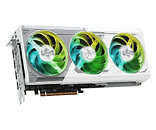
Alphacool Unveils New Eisblock Aurora Arc B580 Steel Legend/Challenger GPU Water Block
Alphacool International GmbH, based in Braunschweig, has been a pioneer in PC water cooling technology for over 20 years. With one of the most comprehensive product portfolios in the industry and over 20 years of experience, Alphacool is now expanding its portfolio with the new Eisblock Aurora Arc B580 Steel Legend + Challenger with Backplate.
The GPU water cooler is precisely tailored to fit the layout of ASRock's Intel Arc B580 Steel Legend and Challenger graphics cards. An updated fin structure, optimized water flow, and an improved jetplate ensure high cooling performance. The chrome-plated copper base offers excellent thermal conductivity and long-lasting durability. Subtle RGB lighting complements the elegant design and provides even illumination.
The GPU water cooler is precisely tailored to fit the layout of ASRock's Intel Arc B580 Steel Legend and Challenger graphics cards. An updated fin structure, optimized water flow, and an improved jetplate ensure high cooling performance. The chrome-plated copper base offers excellent thermal conductivity and long-lasting durability. Subtle RGB lighting complements the elegant design and provides even illumination.





















































































